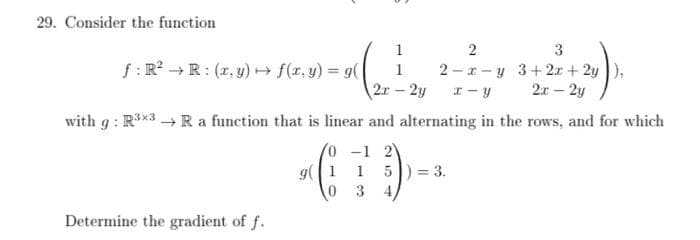29. Consider the function f: R² →R: (x,y) → f(x,y) = g( Determine the gradient of f. 1 1 2x - 2y g(1 0 2 2 x y x-y with g: R³x3 R a function that is linear and alternating in the rows, and for which (0 -1 2 3 3+2x + 2y), 2x - 2y 1 5) = 3. 3 4
29. Consider the function f: R² →R: (x,y) → f(x,y) = g( Determine the gradient of f. 1 1 2x - 2y g(1 0 2 2 x y x-y with g: R³x3 R a function that is linear and alternating in the rows, and for which (0 -1 2 3 3+2x + 2y), 2x - 2y 1 5) = 3. 3 4
Elementary Linear Algebra (MindTap Course List)
8th Edition
ISBN:9781305658004
Author:Ron Larson
Publisher:Ron Larson
Chapter7: Eigenvalues And Eigenvectors
Section7.CM: Cumulative Review
Problem 5CM: Find the kernel of the linear transformation T:R4R4, T(x1,x2,x3,x4)=(x1x2,x2x1,0,x3+x4).
Related questions
Question

Transcribed Image Text:29. Consider the function
3
2
2 x y 3+2x+2y),
x-y 2x - 2y
with g: R³x3 → R a function that is linear and alternating in the rows, and for which
/0 -1 2)
1
3
f: R²R: (x,y) → f(x, y) = g(
Determine the gradient of f.
g(1
0
1
1
2x - 2y
5) = 3.
4,
Expert Solution
This question has been solved!
Explore an expertly crafted, step-by-step solution for a thorough understanding of key concepts.
Step by step
Solved in 2 steps with 1 images

Recommended textbooks for you

Elementary Linear Algebra (MindTap Course List)
Algebra
ISBN:
9781305658004
Author:
Ron Larson
Publisher:
Cengage Learning

Linear Algebra: A Modern Introduction
Algebra
ISBN:
9781285463247
Author:
David Poole
Publisher:
Cengage Learning

Elementary Linear Algebra (MindTap Course List)
Algebra
ISBN:
9781305658004
Author:
Ron Larson
Publisher:
Cengage Learning

Linear Algebra: A Modern Introduction
Algebra
ISBN:
9781285463247
Author:
David Poole
Publisher:
Cengage Learning